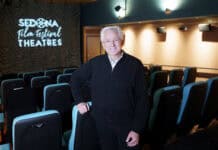Sedona City Manager Justin Clifton was very clear in letting the public know that just because most staff members are out of sight does not mean the residents they serve are out of mind.
The Tuesday, March 24, Sedona City Council meeting was unlike any before. Not only was there no one from the public in chambers —they could watch from the council chamber’s foyer — but staff was limited and the council members sat several feet apart.
Mayor Sandy Moriarty and council members Jessica Williamson and John Currivan were on the dais while Vice Mayor John Martinez and Councilmen Scott Jablow and Bill Chisholm sat at least 10 feet apart with one another in the audience with everyone giving personal space as a result of COVID-19 precautions. Councilwoman Janice Howes Hudson resigned March 21.
Council members — like city staff — pointed out they are trying to make the best of a bad situation.
“The thing I think that is most important from last night is that across the Sedona team we are dedicated to doing everything we can to address the COVID-19 pandemic and all the ways it impacts our local community,” Clifton said the day after the meeting. “We will continue to work around the clock to keep our citizens safe and provide whatever resources we can to get through this unprecedented crisis. In these challenging times, solutions don’t always come instantaneously but our focus and our effort won’t let up until we’re through this.”
Despite the modified seating arrangement, the council meeting went on as scheduled with two-and- a-half hours worth of updates and overviews of the current epidemic. Making things even more challenging in terms of uniformity is that declarations have been issued by not only the city but the counties, state and even at the federal level. Not only that but balancing the health and safety of residents with the economic impact as a result of the coronavirus is on the minds of many.
“Some of this comes down to a lack of uniformed approach,” Clifton said. “I think what the governor is attempting to do is to force some of that uniformed approach. I know that people across the state are on the side of do more or do less. I certainly see the value in doing things consistently. I believe the writing on the wall is, please, let’s do this together.”
Current Sedona restrictions include:
- Group congregation where hygiene and disinfection practices are most difficult.
- Restaurants are take-out only.
- Bars, theaters, gyms, yoga studios, etc., are closed. The closure does not currently affect salons nor spas.
- Drive-thru and takeout are allowed.
- The governor’s order allows limited delivery of alcohol in sealed containers.
- State preemption prohibits cities from imposing shelter-in-place orders nor from closing hotels, banning outdoor recreation and other activities.
Clifton said the city has received numerous calls and emails from residents asking for more to be done and a call for a stay-at-home approach, which several states have taken.
Under the current state proclamation, the city would have to get approval from the governor’s office to do so.
“There’s a lot of misunderstanding and likely misinformation going around,” Clifton said. “We’re getting lots of requests to do other things. At this point I think the most significant obstacle is this attempt to create uniformity.”
Aside from the health concerns — five confirmed cases of COVID-19 in Yavapai County, three of which are in Sedona and 23 cases in Coconino county as of Thursday, March 26 — Clifton also discussed the economic impacts the pandemic is having. There are widespread reports of business closures, layoffs and furloughs with hotels seeing occupancy drop by 10% to 20%. Clifton said loss of income is a serious threat to health and safety.
“It’s unfortunate that some of the rhetoric right now is pitting health and safety against economic prosperity,” he said. “In reality this is probably health and safety — and health and safety. At some point the economic consequences can be so severe that people without income are making decisions between ‘do I eat or do I take my meds?’”
While COVID-19 measures are going on, staff will be monitoring federal bills, offering assistance/guidance with obtaining small business loans and coordinating details at the state level that includes unemployment and business support. The city will also be looking at ways to help support organizations that provide meals or food to area residents.
Moving forward, Clifton said there will be some big challenges on the horizon including:
- Lack of unified approach
- Lack of adherence to social distancing or businesses limitations
- Lack of testing
- Lack of personal protective equipment
- Potential for a steep rise in cases
- Hospitals and health care providers could be overwhelmed
- Economic impact
- Declining city tax revenues
“We’re in a very good position but we need to be prepared,” he said of the city’s economic position.
